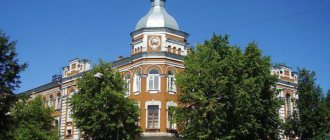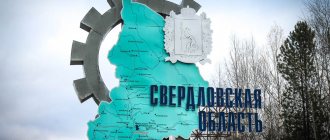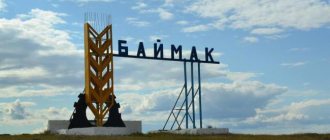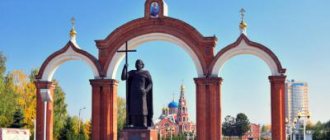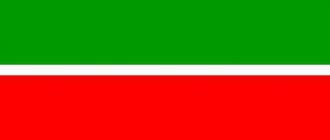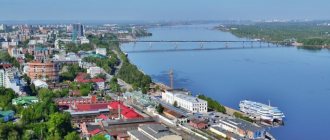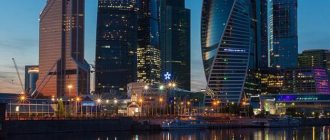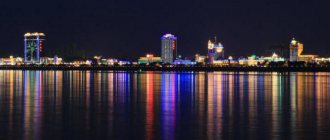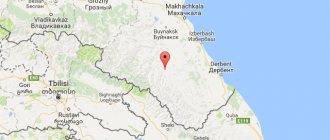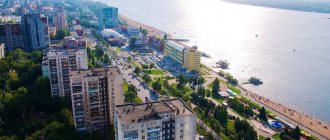NOVOCHEBOXARSK , a city (since 1965) in the Russian Federation, Chuvashia, a port on the Volga, 20 km from the Cheboksary railway station. Population 123.1 thousand people (2002). Production of building materials, cotton spinning factory. It appeared in 1960 as a satellite of Cheboksary. Near Novocheboksarsk there is the Cheboksary hydroelectric station.
| The coat of arms of the city of Novocheboksarsk was adopted on February 24, 1993 and was used until 2005. It is an image of a golden bordered heraldic shield with red stylized ornamental Chuvash symbols. The coat of arms is surmounted by the “three suns” emblem. The symbolism in the center represents the chemical industry and electric power industry. The shield is bordered with azure color. |
KANASH (until 1920 Shikhrany), a city (since 1925) in the Russian Federation, Chuvashia. Railway junction. Population 55.3 thousand people (2002). Mechanical engineering and metalworking (factories: electric forklifts, auto aggregates, etc.); PA "Lakokraska", polymer materials plant; food industry. Museum of Local Lore.
Coat of arms of Kanash.
ALATYR , a city in the Russian Federation, Republic of Chuvashia, is located in the Middle Volga region, on the left bank of the river. Sura, at the confluence of the river. Alatyr, 195 km south of Cheboksary. Railroad station. Airport. District center. Population 46.2 thousand people (2001). Founded in 1552. City since 1780.
Coat of arms of the city of Alatyr. Approved December 22, 1780.
Main industrial enterprises: JSC "Electroavtomat", "Electropribor", electromechanical "Lisma", low-temperature refrigerators, mechanical, "Alba" (production of pianos), "Furniture factory". Enterprises of footwear, textile, food industries. Deposits of peat, clay, sand, etc. have been discovered in the area.
Founded by Ivan the Terrible as a fortified point to protect the borders of the Moscow state at the mouth of the river. Alatyr. Since 1780, the county town of Alatyr. The city has local history and art museums.
Alatyr. The building of the Chuvash University branch.
In the city and its immediate surroundings there are 15 cathedrals and churches, including St. John the Baptist (1703), Nativity of the Virgin Mary (1747). Active monasteries: Holy Trinity Monastery (founded in 1584) and Kiev-Nicholas Novodevichy Women's Monastery (founded in 1634). Stone mansions from the late 19th and early 20th centuries have also been preserved in Alatyr.
There is an arboretum in the city.
The childhood and youth of the sculptor S. D. Erzya (Nefedov), the shipbuilder A. N. Krylov (monuments were erected, memorial house-museums were opened), the gunsmith designer A. I. Sudaev and others passed in Alatyr.
SHUMERLYA , in Chuvashia, republican subordination, regional center, 110 km southwest of Cheboksary. Located on the slopes of the Volga Upland, the pier is on the right bank of the river. Sura. Railway station on the Moscow - Kazan line. Population 42.7 thousand people (1992; 15.2 thousand in 1926; 30.2 thousand in 1959; 36.2 thousand in 1979). It emerged in 1916 as a railway settlement. In the 1930s became the location of a number of industrial enterprises. City - since 1937. In modern Sh.: a caravan plant (built in 1931); factories - special vehicles (1928), chemical (1930); wood processing and food industry enterprises. Sh. is the center of an agricultural region. Museum of History and Local Lore.
| The coat of arms of Shumerli was adopted on February 11, 1976. “In a scarlet shield, inside a silver gear, there is a green oak leaf with two green acorns. Below is a thin shortened wavy azure belt. In the silver head of the shield there is a scarlet national ornament and the name of the city in gold.” |
TSIVILSK , a regional center in Chuvashia, 37 km southeast of Cheboksary. Located on the Volga Upland, on the banks of the river. Bolshoy Tsivil (near the confluence with the Maly Tsivil river), 8 km from the railway station of the same name on the branch to Cheboksary from the Moscow - Kazan line. Road junction (to Cheboksary, Ulyanovsk, Kazan). Population 10.4 thousand people (1992; 2.3 thousand in 1897; 8.3 thousand in 1979). The first mention dates back to 1584, when, by order of Boris Godunov, a fortress inhabited by Russians was built here. In 1609 Ts. was burned by the Cheremis, in 1671 it was attacked by the detachments of S. T. Razin, and in 1774 it was taken by the detachments of E. I. Pugachev. In 1781 Ts. received the status of a district city of the Kazan governorship, and from 1796 - in the Kazan province. At the end of the 19th century. There were 4 stone churches in Tsentralny, and 17 small industrial enterprises operated. The inhabitants were mainly engaged in agriculture. Since 1920, Ts. was part of the Chuvash Autonomous Okrug, in 1925-90 - in the Chuvash Autonomous Soviet Socialist Republic. In modern Central Asia: food and light industry enterprises; brick and car repair factories. Museum of Local Lore.
| Coat of arms of the city of Tsivilsk and Tsivilsky district, adopted on July 25, 2002. In a golden field at the green narrow end there is a scarlet (red) oak with acorns, green foliage and black ridges at the base. In the free part there are symbols of Chuvashia. The motto “Many Years” is written in gold letters on a green ribbon lined with gold. |
Republic of Chuvashia: general information
Chuvashia is one of the republics within the Russian Federation. It is located in the center of the European part of the country. The Volga River flows in the north of the republic. The distance from the “capital” of the region to the capital of Russia is 630 km.
The republic occupies a small (by Russian standards) area: about 18,000 square kilometers. The population of Chuvashia is 1.23 million people. The republic is quite well connected with other regions of Russia by road, rail, and water transport routes.
Most of Chuvashia is located between the Sura and Sviyaga rivers, within the forest and forest-steppe natural zones. The relief of the territory is flat, the climate is temperate continental. Among the mineral resources in the region, there are deposits of oil shale and phosphorites.
Chuvashia is a land with rich culture and traditions. It is often called "the land of a hundred thousand songs." Researchers focus on the uniqueness of local musical culture, which is expressed not only in a special style of singing, but also in a set of instruments.
Cities and regions of the Chuvash Republic - Chuvashia.
Cities of the Republic of Chuvashia:
Alatyr, Kanash, Kozlovka, Mariinsky Posad, Novocheboksarsk, Tsivilsk, Shumerlya, Yadrin.
Urban districts of the Chuvash Republic - Chuvashia:
"City of Cheboksary"; "City of Alatyr"; "City of Kanash"; "City of Novocheboksarsk"; "Sumerlinsky".
Municipal districts - Administrative center:
Alatyr district - Alatyr city; Alikovsky district - village. Alikovo; Batyrevsky district - village. Batyrevo; Vurnarsky district - urban settlement. Vurnars; Ibresinsky district - town. Ibresi; Kanashsky district - Kanash city; Kozlovsky district - Kozlovka city; Komsomolsky district - village. Komsomolskoe; Krasnoarmeysky district - village. Krasnoarmeyskoe; Krasnochetaisky district - village. Red Chetai; Marposadsky district - Mariinsky Posad; Morgaushsky district - village. Morgaushi; Poretsky district - village. Poretskoe; Urmara district - Urmary village; Tsivilsky district - Tsivilsk city; Cheboksary district - Kugesi village; Shemurshinsky district - village. Shemursha; Shumerlinsky district - Shumerlya city; Yadrinsky district - Yadrin city; Yalchik district - village. Yalchiki; Yantikovsky district - village. Yantikovo
The Republic of Chuvashia is located on the right bank of the Volga River in the middle of its tributaries Suroy and Sviyaga. There are more than 750 large and small lakes on the territory of the Republic. In the northern part of Chuvashia there are mainly terrain with ravines, and in the southern part there is a plain with hills.
The Chuvash Republic is a federal subject. Its area is 18.3 thousand km2.
Climatic features
The temperate continental climate prevails on the territory of Chuvashia. During the year, according to average data, 400-600 mm of precipitation falls.
Residents of the republic
More than 1.3 million people live in Chuvashia, of which about 40% are rural residents.
The Chuvash Republic has 21 districts, nine cities, eight urban settlements and more than 1,700 villages, villages and hamlets. The capital of Chuvashia is Cheboksary, where about half a million people live. At the end of 2001, the city was rated as the most attractive large settlement in Russia.
History of the Chuvash people
As researchers say, the first people inhabited these lands 50-70 thousand years ago. In the 4th-3rd millennium BC. e. Finno-Ugrians, who are the ancestors of the present-day Mordovians and Maris, lived here. The Bulgarian and Sabir tribes, who became the ancestors of the Chuvash, lived in Siberia, and their forefathers were the Huns, steppe nomads who eventually abandoned nomadic life and took up arable farming and the production of tools. In the 10th century, Volga Bulgaria appeared on the territory of Chuvashia - a famous state in the early Middle Ages. In the 13th century it fell to the Golden Horde and became part of it. In 1438, after the collapse of the Golden Horde, Volga Bulgaria became part of the Kazan Khanate. At this time, the Chuvash had to hide in the forests from forced Islamization. In the mid-16th century, Chuvashia independently joined the Russian state. It is from this moment that the formation of the Chuvash people takes place. In 1920, the Chuvash Autonomous Republic was formed, and five years later the Chuvash Autonomous Soviet Socialist Republic was created. Since 1992, this territory received the name of the Chuvash Republic.
Industry and agriculture
There are 12 powerful industrial enterprises in the Republic that produce complex electrical mechanisms and apparatus, refrigeration chambers, soda, resin, high-quality plastic, as well as knitwear, furniture, reinforced concrete structures and much more. About 60 collective farms and more than 1,200 farms are registered in Chuvashia, producing grain and vegetable crops, potatoes, meat and dairy products and eggs. Many types of cattle, pigs of various breeds are raised here, there are many herds of sheep and herds of horses.
NOVOCHEBOXARSK
, a city (since 1965) in the Russian Federation, Chuvashia, a port on the Volga, 20 km from the Cheboksary railway station. Population 123.1 thousand people (2002). Production of building materials, cotton spinning factory. It appeared in 1960 as a satellite of Cheboksary. Near Novocheboksarsk there is the Cheboksary hydroelectric station.
KANASH
(until 1920 Shikhrany), city (since 1925) in the Russian Federation, Chuvashia. Railway junction. Population 55.3 thousand people (2002). Mechanical engineering and metalworking (factories: electric forklifts, auto aggregates, etc.); PA "Lakokraska", polymer materials plant; food industry. Museum of Local Lore.
ALATYR
, a city in the Russian Federation, the Republic of Chuvashia, is located in the Middle Volga region, on the left bank of the river. Sura, at the confluence of the river. Alatyr, 195 km south of Cheboksary. Railroad station. Airport. District center. Population 46.2 thousand people (2001). Founded in 1552. City since 1780.
Coat of arms of the city of Alatyr. Approved December 22, 1780.
Main industrial enterprises: JSC "Electroavtomat", "Electropribor", electromechanical "Lisma", low-temperature refrigerators, mechanical, "Alba" (production of pianos), "Furniture factory". Enterprises of footwear, textile, food industries. Deposits of peat, clay, sand, etc. have been discovered in the area.
Founded by Ivan the Terrible as a fortified point to protect the borders of the Moscow state at the mouth of the river. Alatyr. Since 1780, the county town of Alatyr. The city has local history and art museums.
Alatyr. The building of the Chuvash University branch.
In the city and its immediate surroundings there are 15 cathedrals and churches, including St. John the Baptist (1703), Nativity of the Virgin Mary (1747). Active monasteries: Holy Trinity Monastery (founded in 1584) and Kiev-Nicholas Novodevichy Women's Monastery (founded in 1634). Stone mansions from the late 19th and early 20th centuries have also been preserved in Alatyr.
There is an arboretum in the city.
The childhood and youth of the sculptor S. D. Erzya (Nefedov), the shipbuilder A. N. Krylov (monuments were erected, memorial house-museums were opened), the gunsmith designer A. I. Sudaev and others passed in Alatyr.
SHUMERLYA
, in Chuvashia, republican subordination, regional center, 110 km southwest of Cheboksary. Located on the slopes of the Volga Upland, the pier is on the right bank of the river. Sura. Railway station on the Moscow - Kazan line. Population 42.7 thousand people (1992; 15.2 thousand in 1926; 30.2 thousand in 1959; 36.2 thousand in 1979). It emerged in 1916 as a railway settlement. In the 1930s became the location of a number of industrial enterprises. City - since 1937. In modern Sh.: a caravan plant (built in 1931); factories - special vehicles (1928), chemical (1930); wood processing and food industry enterprises. Sh. is the center of an agricultural region. Museum of History and Local Lore.
TSIVILSK
, regional center in Chuvashia, 37 km southeast of Cheboksary. Located on the Volga Upland, on the banks of the river. Bolshoy Tsivil (near the confluence with the Maly Tsivil river), 8 km from the railway station of the same name on the branch to Cheboksary from the Moscow - Kazan line. Road junction (to Cheboksary, Ulyanovsk, Kazan). Population 10.4 thousand people (1992; 2.3 thousand in 1897; 8.3 thousand in 1979). The first mention dates back to 1584, when, by order of Boris Godunov, a fortress inhabited by Russians was built here. In 1609 Ts. was burned by the Cheremis, in 1671 it was attacked by the detachments of S. T. Razin, and in 1774 it was taken by the detachments of E. I. Pugachev. In 1781 Ts. received the status of a district city of the Kazan governorship, and from 1796 - in the Kazan province. At the end of the 19th century. There were 4 stone churches in Tsentralny, and 17 small industrial enterprises operated. The inhabitants were mainly engaged in agriculture. Since 1920, Ts. was part of the Chuvash Autonomous Okrug, in 1925-90 - in the Chuvash Autonomous Soviet Socialist Republic. In modern Central Asia: food and light industry enterprises; brick and car repair factories. Museum of Local Lore.
Dynamics and population of the republic
Chuvashia is one of the most populated subjects of the Russian Federation. As of 2016, 1 million 237 thousand people live here. At the same time, the average population density of Chuvashia is one of the highest in Russia (almost 68 people/sq. km.).
However, the demographic situation in the republic has remained very difficult for twenty years. Since 1994, the population of Chuvashia has been gradually dying out. During this period of time, the region lost almost 100 thousand of its inhabitants! True, by 2016 the rate of population extinction had slowed down, primarily due to an increase in the birth rate.
Another serious demographic problem in the region is the “aging” of the population. The fact is that young people are actively leaving the republic. Accordingly, the proportion of people of retirement age in the age structure of the population is increasing.
The level of urbanization in the region is relatively low - 61.3%. However, recently the urban population of the Republic of Chuvashia is increasing every year.
Notes
When Mikhail Ivanovich entered, there were tears in his eyes, memories of the time when he wrote what he was now reading.
He took the letter from Mikhail Ivanovich’s hands, put it in his pocket, put away the papers and called Alpatych, who had been waiting for a long time. On a piece of paper he wrote down what was needed in Smolensk, and he, walking around the room past Alpatych, who was waiting at the door, began to give orders. - First, postal paper, do you hear, eight hundred, according to the sample; gold-edged... a sample, so that it will certainly be according to it; varnish, sealing wax - according to a note from Mikhail Ivanovich. He walked around the room and looked at the memo. “Then personally give the governor a letter about the recording. Then they needed bolts for the doors of the new building, certainly of the style that the prince himself had invented. Then a binding box had to be ordered for storing the will. Giving orders to Alpatych lasted more than two hours. The prince still did not let him go. He sat down, thought and, closing his eyes, dozed off. Alpatych stirred. - Well, go, go; If you need anything, I will send it. Alpatych left. The prince went back to the bureau, looked into it, touched his papers with his hand, locked it again and sat down at the table to write a letter to the governor. It was already late when he stood up, sealing the letter. He wanted to sleep, but he knew that he would not fall asleep and that his worst thoughts came to him in bed. He called Tikhon and went with him through the rooms to tell him where to make his bed for that night. He walked around, trying on every corner. Everywhere he felt bad, but the worst thing was the familiar sofa in the office. This sofa was scary to him, probably because of the heavy thoughts that he changed his mind while lying on it. Nowhere was good, but the best place of all was the corner in the sofa behind the piano: he had never slept here before. Tikhon brought the bed with the waiter and began to set it up. - Not like that, not like that! - the prince shouted and moved it a quarter away from the corner, and then again closer. “Well, I’ve finally done everything over, now I’ll rest,” the prince thought and allowed Tikhon to undress himself. Frowning in annoyance from the efforts that had to be made to take off his caftan and trousers, the prince undressed, sank heavily onto the bed and seemed to be lost in thought, looking contemptuously at his yellow, withered legs. He didn’t think, but he hesitated in front of the difficulty ahead of him to lift those legs and move on the bed. “Oh, how hard it is! Oh, if only this work would end quickly, quickly, and you would let me go! - he thought. He pursed his lips and made this effort for the twentieth time and lay down. But as soon as he lay down, suddenly the whole bed moved evenly under him back and forth, as if breathing heavily and pushing. This happened to him almost every night. He opened his eyes that had closed. - No peace, damned ones! - he growled with anger at someone. “Yes, yes, there was something else important, I saved something very important for myself in bed at night. Valves? No, that's what he said. No, there was something in the living room. Princess Marya was lying about something. Desalle—that fool—was saying something. There’s something in my pocket, I don’t remember.” - Quiet! What did they talk about at dinner? - About the prince, Mikhail... - Shut up, shut up. “The prince slammed his hand on the table. - Yes! I know, a letter from Prince Andrei. Princess Marya was reading. Desalles said something about Vitebsk. Now I'll read it. He ordered the letter to be taken out of his pocket and a table with lemonade and a vitushka - a wax candle - to be moved towards the bed and, putting on his glasses, he began to read. Here only in the silence of the night, in the faint light from under the green cap, did he read the letter for the first time and for a moment understand its meaning. “The French are in Vitebsk, after four crossings they can be at Smolensk; maybe they’re already there.” - Quiet! - Tikhon jumped up. - No, no, no, no! - he shouted. He hid the letter under the candlestick and closed his eyes. And he imagined the Danube, a bright afternoon, reeds, a Russian camp, and he enters, he, a young general, without one wrinkle on his face, cheerful, cheerful, ruddy, into Potemkin’s painted tent, and a burning feeling of envy for his favorite, just as strong, as then, worries him. And he remembers all the words that were said then at his first Meeting with Potemkin. And he imagines a short, fat woman with yellowness in her fat face - Mother Empress, her smiles, words when she greeted him for the first time, and he remembers her own face on the hearse and that clash with Zubov, which was then with her coffin for the right to approach her hand. “Oh, quickly, quickly return to that time, and so that everything now ends as quickly as possible, as quickly as possible, so that they leave me alone!” Bald Mountains, the estate of Prince Nikolai Andreich Bolkonsky, was located sixty versts from Smolensk, behind it, and three versts from the Moscow road.
Age, sex composition of the population and migration
As mentioned above, in Chuvashia the proportion of pensioners is increasing every year. Accordingly, the proportion of minors is decreasing. If in 1989 it was almost 27%, then in 2002 it was only 19.9%.
If we talk about the gender structure of the population, women predominate in Chuvashia (53.7%). However, in recent years there has been a tendency towards equalizing the overall ratio of men and women.
The population of Chuvashia is declining not only due to natural demographic processes, but also due to active emigration. Over the past five years, the region has seen negative migration dynamics. On average, every year 2-5 thousand more people leave Chuvashia than enter the republic. The main centers of attraction for migrants from this region are Moscow, Ulyanovsk region, Tatarstan and the Moscow region.
see also
- Chuvashia
- Cities of Russia
| [ + ] Cities by regions of Russia | |
| Cities of the North-West (NWFD) | St. Petersburg (and its cities) • Leningrad region (historical Staraya Ladoga) • Arkhangelsk region • Vologda region • Kaliningrad region • Karelia • Komi • Murmansk region • Nenets Autonomous Okrug • Pskov region |
| Cities of the Volga region (Volga Federal District) | Bashkortostan • Volgograd region • Kalmykia • Kirov region • Mari El • Mordovia • Nizhny Novgorod region • Orenburg region • Penza region • Perm region • Samara region • Saratov region • Tatarstan • Udmurtia • Ulyanovsk region • Chuvashia |
| Cities of Southern Russia (SFD) | Sevastopol (including Inkerman) • Republic of Crimea • Adygea • Astrakhan region • Krasnodar region • Rostov region |
| Cities of the North Caucasus (NCFD) | Dagestan • Ingushetia • Kabardino-Balkaria • Karachay-Cherkessia • North Ossetia - Alania • Stavropol Territory • Chechen Republic |
| Cities of the Urals (Ural Federal District) | Kurgan region • Sverdlovsk region • Tyumen region • Khanty-Mansi Autonomous Okrug - Yugra • Chelyabinsk region • Yamalo-Nenets Autonomous Okrug |
| Cities of Siberia (Siberian Federal District) | Altai Republic • Altai Territory • Irkutsk Region • Kemerovo Region • Krasnoyarsk Region • Novgorod Region • Novosibirsk Region • Omsk Region • Tomsk Region • Tyva • Khakassia |
| Cities of the Far East (FEFD) | Amur Region • Buryatia • Jewish Autonomous Region • Trans-Baikal Territory • Kamchatka Territory • Magadan Region • Primorsky Territory • Sakha (Yakutia) • Sakhalin Region • Khabarovsk Territory • Chukotka Autonomous Region |
| see also | Cities of the DPR, LPR, Transnistria, South Ossetia • Regions of Russia • Cities of Russia |
Ethnic composition of the population. Who are the Chuvash?
The national composition of the republic is dominated by the Chuvash (67.7%). Next come Russians (26.7%), Tatars (2.8%) and Mordovians (about 1%). Also on the territory of Chuvashia there are quite numerous diasporas of Ukrainians, Belarusians and Armenians.
Chuvash are the indigenous population of the republic. This is a Turkic ethnic group, the origin of which scientists associate with the Volga Bulgars. The total number of Chuvash in the world is estimated at one and a half million people. Half of them live within the Chuvash Republic. The remaining representatives of this ethnic group are scattered throughout the territory of Russia; they also live in Kazakhstan, Uzbekistan, Ukraine and some other countries.
The Chuvash speak their own language – Chuvash, which has three dialects. In 65% of schools in the region, children are taught in this language. Most of the Chuvash are Orthodox Christians. However, among them there are also adherents of traditional pagan beliefs.
According to ancient Chuvash myths, the Earth has the shape of a square. The firmament rests on four pillars (copper, stone, gold and silver). Each of the four corners of the Earth is reliably guarded by a hero-defender.
Yadrin
Yadrin
, a regional center in Chuvashia, 86 km southwest of Cheboksary. Located on the left bank of the river. Sura, 59 km from the Shumerlya railway station on the Moscow - Kazan line. Population 10.6 thousand people (1992; 7 thousand in 1979). Known since 1590. According to Chuvash legends, the city was named after the pagan Chuvash. In 1708 Yadrin was assigned to the Kazan province, and in 1781 received the status of a district town of the Kazan province. In modern Yadrin: enterprises of the metalworking, food and clothing industries; production of building materials. Near Yadrina, on the banks of the Sura, there is the Chuvash stud farm. The creator of the 17-volume Dictionary of the Chuvash Language, N. I. Ashmarin, and the artist N. D. Mordvinov were born in Yadrino.
NOVOCHEBOXARSK
, in Chuvashia, republican subordination. Located on the slopes of the Volga Upland, on the right bank of the Volga, 5 km below the city of Cheboksary (the nearest railway station to N.). River port. Airport. Population 120.2 thousand people (1992; 39 thousand in 1970; 86.5 thousand in 1979). It emerged in 1960 as a builders’ settlement during the construction of the Cheboksary hydroelectric power station. City - since 1965. In modern N.: production of building materials; light and food industry enterprises; a chemical plant is under construction (1992).
MARIINSKY POSAD
, regional center in Chuvashia, 48 km east of Cheboksary. Located on the right bank of the river. Volga, at the confluence of the river. Syndyrka. Pier (Kuibyshev Reservoir). The nearest railway station is Cheboksary. Population 10.7 thousand people (1992). Known since the beginning of the 17th century. like the village of Sundyr. At the request of residents of the village of Sundyr with adjacent villages in 1856 it was transformed into the city of M.P. Cheboksary district of the Kazan province. In modern MP: factories - cable products, car repair, machine-building, building materials, alcohol, creamery, etc. Museum of Local Lore.
KOZLOVKA
, regional center in Chuvashia, 95 km southeast of Cheboksary. Located on the right bank of the Volga (Kuibyshev Reservoir). It is connected by a road (9 km) to the Kazan-Moscow highway and the Tyurlema railway station on the Moscow-Kazan line. Population 13.1 thousand people (1992; 11.4 thousand in 1979). City - since 1967. Van plant, creamery.
Modern territorial structure of the republic. Population of Chuvashia by region
The Republic of Chuvashia today is divided into 21 administrative districts. There are nine cities, eight urban settlements and 1,720 villages. The capital of the republic is the city of Cheboksary. According to the latest census, every third resident of Chuvashia lives there.
The regions of the republic vary in size. The largest in area is Alatyrsky, and the smallest is Krasnoarmeysky. The table below presents all regions of Chuvashia, indicating the population for each of them:
| District name | Number of inhabitants (thousand people) |
| Alatyrsky | 15,2 |
| Alikovsky | 16,3 |
| Batyrevsky | 35,1 |
| Vurnarsky | 32,8 |
| Ibresinsky | 23,9 |
| Kanashsky | 36,3 |
| Krasnoarmeisky | 14,6 |
| Krasnochetaysky | 14,9 |
| Kozlovsky | 19,7 |
| Komsomol | 25,6 |
| Marposadsky | 22,7 |
| Morgaushsky | 33,5 |
| Poretsky | 12,8 |
| Urmarsky | 23,6 |
| Tsivilsky | 36,2 |
| Cheboksary | 62,5 |
| Shumerlinsky | 9,4 |
| Shemurshinsky | 12,8 |
| Yadrinsky | 26,9 |
| Yantikovsky | 15,2 |
| Yalchiksky | 17,9 |
Natural attractions
Prisursky State Reserve
Coordinates: N 55.01.31, E 46.45.25 Website: prisursky.ru How to get there: - by car along the Anish road (to the Ibresi-Alatyr section); — by train “Kanash – Red Knot” to the Atrat junction.
The total area of the natural reserve, located on the territory of three administrative districts of the republic, is 9,150 hectares. The reserve is young: it was founded in 1995.
The main section of the reserve is located in the valley of the Sura River in the Alatyr region. The main attraction of this place is the coniferous forests. In other areas of the protected areas there are forest-steppes, on the territory of which many rare species of plants grow, which are of real value for science. The pride of the reserve is the floating water chestnut, listed in the Red Book of Russia. Among the fauna you can find pine marten, elk, lynx, brown bear, white hare, steppe marmots - bobak and other inhabitants.
The Prisursky Nature Reserve offers walking or horseback excursions.
White Lake
Coordinates: N 55.10.22, E 47.44.50 How to get there: you need to go to the Yalchik district of Chuvashia, landmark - the village of Belaya Ozero
The White Lake of karst origin is a natural monument of regional importance and in terms of its volume ranks second in the republic. At the same time, the depth of the lake is small, only about 3-4 meters. But the total area reaches 18 hectares.
Despite the fact that White Lake is surrounded by shores overgrown with plants and trees, the reservoir itself is not overgrown with mud and reeds. The lake water remains clear and clean all year round.
Lake Izyar
Coordinates: N 56.16.57, E 47.15.04 How to get there: from Cheboksary, go from the Station bus station by bus No. 204, heading to Sosnovka to the Astrakhanka stop.
Lake Izyar is called a legend of Chuvashia. It is located only 30 kilometers from the main city of the republic - Cheboksary.
The name “Izyar” translated from the Mari language means “small lake”. And this is true: the area of the reservoir is 4 hectares, and the maximum depth is no more than 3.5 meters.
The lake is unique for its water, which does not have any smell or color. Izyar is surrounded on all sides by birch, pine and aspen forests. Since 1981, the lake has been a national natural monument of regional significance.
Sovereign Mountain
Coordinates: N 56.07.174, E 47.44.235 How to get there: to Mariinsky Posad, then through Kalininskaya Street - another 2.5 km
If you believe the legend, Catherine the Great loved this place in the Chuvash Republic. She came here in 1763. Then, on the way from Kazan, the Empress visited Sundyr. To impress Catherine, all the local nobility arranged a luxurious dinner right in the open air, on this very mountain. Later she received her name - Gosudareva.
And in 1768, the famous Catherine Grove was founded at the foot of the mountain. Majestic oak trees still grow there.
From the observation deck you can see the entire Mariinsky Posad and part of the Volga.
Lake Svetloe
Coordinates: N 56.14.44, E 46.59.56 How to get there: the lake is located on the territory of the Zavolzhye natural park, 18 km northwest of the village of Sosnovka and 1 km from the Parat River
Lake Svetloe is located in close proximity to the border of Chuvashia and Mari El, and has clean and clear water. But at the same time, the second name of the lake - Shundy-yar - comes from the Mari word “shun” (which means “clay”). Probably, this name was given to the lake for the reason that part of the bottom and shore of the lake is clayey. However, the lake also lives up to its main name: the water here is so clean that its transparency reaches two meters in depth.
Like most lakes in the Chuvash Republic, Svetloe also has a karst origin and a regular oval shape. The area of the lake reaches 13 hectares, and its greatest depth is 16 meters.
Waterfall "Silver Cascade"
Coordinates: N 56.09.567, E 46.51.822 How to get there: approximate point - the village of Kuskino in the Morgushansky district. After passing through the village, you need to come to a deciduous forest, through which the road leads to the waterfall. It will take about 10 minutes to walk through the forest.
Waterfalls on the flat territory of the Volga region are a rare, almost unique phenomenon. One of these rare examples is the “Silver Cascade” - the largest waterfall in Chuvashia. The waterfall was discovered only in 1999, since the forest reliably hides this natural attraction. Today, tourists have already trodden the path to it.
Initially, the height of the waterfall reached 10 meters, but the clay soil, collapsing from the influence of water, gradually makes the “Silver Cascade” lower and lower. Today the height of the waterfall in Chuvashia is 4 meters.
The waterfall originates from the underground flows of the Sundyr River and spring sources. Under the waterfall itself, rock falls formed a cave into which the waters of the Silver Cascade rush.
It is not recommended to go close to the waterfall and the cave, because the unstable clay soil can collapse under your feet at any moment.
Lake Al
Coordinates: N 55.36.12, E 47.43.45 How to get there: the main landmarks are the village of Belyaevo (1.7 km to the south), Nyushkasy (2 km to the east), Aldiarovo (2.2 km to the southeast). Also 700 meters east of the lake there is the Yantikovo - Shorkistry highway.
Lake Al, located in the Yatnikovsky district of the Chuvash Republic, is a natural monument of regional significance. Like other lakes of karst origin, Al is distinguished by its perfectly oval shape and clear water.
There are many legends associated with the lake. According to one of them, there is an underwater island approximately in the middle of the lake. If you stand on it, the water level will only be up to your neck. Another legend, on the contrary, says that the lake has no bottom and is connected by some underground channels to the ocean. This belief appeared after a funny incident when one soldier dropped his cap into the lake, and then it was found in the Caspian Sea.
Pilgrims often came to Lake Al to pray to the hills. A ritual was widespread among them: lighted candles were attached to wood chips and launched into the water. In this way they appeased the spirits of the lake, and also left them hotels and donations.
There is still a sign: when clouds rise from behind the lake, they will definitely fall with long and heavy torrential rains. Local residents believe that the water of the lake can heal from illnesses and cleanse from sins.
Lake Syutkul
Coordinates: N 55.53.49, E 46.36.40 How to get there: follow the Morgaush district, to the southern outskirts of the village of Syutkul
Among more than 750 lakes of the Chuvash Republic, Syutkul is the deepest: the depth reaches 16.75 meters. At the same time, the dimensions of the lake are very compact: the width of the reservoir is 140 meters, the length is 250 meters.
If you believe the words of local residents, cold underground springs flow through the clay bottom of the lake, so the reservoir cannot boast of warm water even in the summer months. And there are almost no places for swimming on the lake: the banks are overgrown with tall grass. Among local residents, Syutkul is used mainly for domestic needs and for fishing. There are quite a few species of fish here, including tench, roach, rudd, bream, carp and crucian carp.
Cities of Chuvashia
The list of cities in Chuvashia includes nine settlements. Two of them are large cities. But the smallest is home to only 8.5 thousand people.
Cheboksary is considered the oldest city within the republic (first mentioned in written documents in 1469). In the 16th century, three more cities arose - Alatyr, Yadrin and Tsivilsk.
Below are all the cities of Chuvashia by population (from largest to smallest):
- Cheboksary.
- Novocheboksarsk.
- Kanash.
- Alatyr.
- Shumerlya.
- Tsivilsk.
- Kozlovka.
- Mariinsky Posad.
- Yadrin.
Cities and villages
Cheboksary
The capital of the Chuvash Republic, Cheboksary, traces its history back to the 13th century. The first chronicle mentions of the city date back to 1469.
Overview of all the important sights of the city.
About 500 thousand people live in Cheboksary.
In the national language, the name of the city sounds like “Shupashkar”. One of the Chuvash legends tells how one day an old man named Shupash and his grandson, after long wanderings, approached a clear lake to quench their thirst. The water in the lake turned out to be very tasty, and the landscapes surrounding the lake were mesmerizing. The old man and his grandson liked this place so much that they decided to stay and live here.
Another legend of the appearance of the city’s name is also connected with water. Shupashkar, translated from an ancient dialect, can mean “surrounded by water.” Cheboksary is surrounded by rivers from different sides. And earlier, on one of the sides, the city was also defended by a ditch filled with water.
The exact history of the origin of the city's name has not yet been determined. There is still debate among historians on this matter, and there are quite a few versions.
- Monument "Patroness Mother". The monument, rising to a height of 46 meters, is the main symbol of Cheboksary and the entire Chuvash Republic. Standing on a high pedestal at the top of the hill, the woman statue spread out her arms, blessing and protecting her children, the residents of the city.
- Cheboksary Bay. The bay in the historical center of Cheboksary was created artificially at the place where the Cheboksary River flows into the Volga. Once upon a time, the old part of the city was located on the site of the bay, but it was flooded during the construction of a hydroelectric power station. Over time, the bay was landscaped and turned into a recreation area for residents and guests of the city. Near the bay there is the Alley of Love, where lovers make dates.
- Merchant Efremov Boulevard. Along the street there are historical buildings built in the 19th century, including the colorful family mansion of the Efremovs. There is also a beer museum, the Chuvash Drama Theater, a monument to Ostap Bender and Kisa Vorobyaninov, many restaurants, shops and souvenir stalls.
- Beer Museum. Cheboksary brews very tasty beer, which is not inferior in quality to well-known producers. In addition, most of the hops for Russian beer are grown in Chuvashia. The museum exposition tells about the history of the foamy drink and its production technologies.
- Chapaev Square. The square was built exactly on the spot where Vasily Chapaev’s native village, Budaiki, used to be. In the center there is a memorial museum and a monument to Chapaev. It is interesting that when working on the monument, a funny mistake was made, due to which both of Vasily Ivanovich’s boots became right.
Shorshely
The small village of Shorshely is located in the Mariinsko-Posad district of Chuvashia, 30 kilometers from Cheboksary. Translated from the Chuvash language, the name of the village means “bright springs”. About 900 people live here. The third cosmonaut in history, Andriyan Grigorievich Nikolaev, was born, lived and buried in the village.
- Space Museum. In total, more than 5,000 exhibits are collected here, including the descent module of the Vostok spacecraft, the cosmonaut's cradle, a space suit, and a diving suit in case of splashdown. Over the 40 years of the museum’s existence, about two million people visited it.
- Memorial complex to USSR pilot-cosmonaut A. G. Nikolaev. In addition to the cosmonautics museum, the museum complex of A.G. Nikolaev also includes the Nikolaev house-museum, a memorial stele and a chapel where the cosmonaut is buried.
Kozlovka
Kozlovka is a city in Chuvashia with a population of about 9,500 people. To get to Kozlovka from Cheboksary, it will take a little over an hour - the distance between the cities is 100 kilometers. In the 19th century, the Russian scientist Nikolai Lobachevsky lived in Kozlovka.
- House-museum of Nikolai Lobachevsky. The building was built by the scientist himself, who lived here from 1840 to 1855. Today, two halls of the museum, one of a kind, are dedicated to the life and research of Lobachevsky. There is also an exhibition hall where works by local artists and students of the art school are shown.
- Kazan-Bogoroditskaya Church. The ancient church in Kozlovka was built back in 1698. Under Soviet rule, the Kazan-Virgin Church was closed in 1936, and in 1961 it was completely destroyed. They planned to build a road from the bricks of the demolished temple, but these plans did not come true. In 2005, the church in Kozlovka was recreated in its original form. An old underground passage was built from the church, which leads to a spring in the Belovolzhsky ravine. According to legend, part of the wealth of the old destroyed temple is hidden in an underground passage, the length of which is 200-300 meters.
- House of the Barons of Jomini. The estate of the barons of Jomini used to belong to representatives of the Russian nobility. The two-story mansion has 15 rooms; next to the house there is an ancient park. Before the start of the October Revolution, Zhomini were among the largest landowners in Chuvashia. But in 1918, all the property of the barons was confiscated. Today, in the estate, which adorns the appearance of the city, there is a society for the disabled.
Novocheboksarsk
The construction of Novocheboksarsk began in 1960, when satellite cities began to appear near large cities throughout Russia. Initially, the new settlement began to be built on free territories, but as it grew, it gradually absorbed the surrounding villages. Today Novocheboksarsk is rightfully considered one of the most comfortable and beautiful cities in Chuvashia. About 126 thousand people live here.
- Cathedral of St. Prince Vladimir. The first stone of the Cathedral of St. Prince Vladimir was laid in 1990. The construction of the temple took three years, and after another year the first service was held in it.
- "Elnikovskaya Grove". The Elnikovskaya Grove cultural and recreation park appeared almost along with the city. In 1995, part of the park was taken under state protection in order to preserve the diversity of vegetation and restore the biological diversity of the region.
- Hydropower Museum. The hydroelectric power station on the Volga, located next to the city, largely shapes its appearance. The entire history of its construction and the technology of its modern functioning can be found out in the Museum of Hydropower in two exhibition halls.
The city of Cheboksary is the capital of the republic
Cheboksary is the largest city in Chuvashia. In addition to its capital status, it is also an important cultural, scientific and transport center of the region. In 2001, the city received the honorary title of “the most comfortable” in Russia.
Cheboksary is located on the Volga River. The transport gates of the city are the airport, railway station and river port.
The city arose in the middle of the 15th century. By the beginning of the 18th century, it turned into a major center of trade in the Volga region. Bread, furs, fish, honey and salt are actively traded here. Currently, more than a dozen large enterprises operate in Cheboksary. Industrial tractors, electronic devices and optical equipment, textiles, and confectionery products are produced here. Two local factories produce a wide range of alcoholic products.
Cheboksary is also known as a recreational center in the region. Thus, on the left bank of the Volga there is the Chuvashia sanatorium, which provides health services, as well as services for the treatment and diagnosis of various diseases.
Cheboksary is an important educational and cultural center of Chuvashia. There are five universities operating here, as well as a number of branches of non-resident higher educational institutions. The city has eight museums, five theaters and more than 30 public libraries. Several major festivals are held in Cheboksary every year.
Among the architectural monuments of the city, it is worth noting several beautiful ancient temple buildings and complexes. In particular, the Vvedensky Cathedral of 1651, the Holy Trinity Monastery, founded in the 17th century, the Assumption Church (1763). More than thirty monuments, sculptural compositions and monuments were installed in the city at different times. The most beautiful and famous of them are the Mother monument (which is considered the main tourist symbol of Cheboksary), the magnificent equestrian monument to Chapaev, the bust of the poet Nizami Ganjavi and others.
Urban settlements
Former towns with urban population
- Buinsk has been a town since 1938. Since December 2005, it has been counted as a rural settlement while maintaining the status of an urban-type settlement[3].
- Vurnary has been a town since 1938. Since December 2005, it has been counted as a rural settlement while maintaining the status of an urban-type settlement[3].
- Ibresi has been a town since 1938. Since December 2005, it has been counted as a rural settlement while maintaining the status of an urban-type settlement[3].
- Kirya has been a town since 1938. Converted to a rural settlement in 2004.
- Kozlovka has been a town since 1938. Incorporated into a city in 1967.
- Kugesi has been a town since 1985. Since December 2005, it has been counted as a rural settlement while maintaining the status of an urban-type settlement[3].
- New Lapsary has been a town since 1979. Since December 2005, it has been counted as a rural settlement while maintaining the status of an urban-type settlement[3].
- Sosnovka has been a town since 1971. Since December 2005, it has been counted as a rural settlement while maintaining the status of an urban-type settlement[3].
- Urmary has been a town since 1947. Since December 2005, it has been counted as a rural settlement while maintaining the status of an urban-type settlement[3].
- Chapaevsky has been a town since 1941. Included within the city limits of Cheboksary in 1959.
- Shumerlya has been a town since 1930. Incorporated into a city in 1937.
- Yuzhny - included within the city limits of Cheboksary in 1959.

